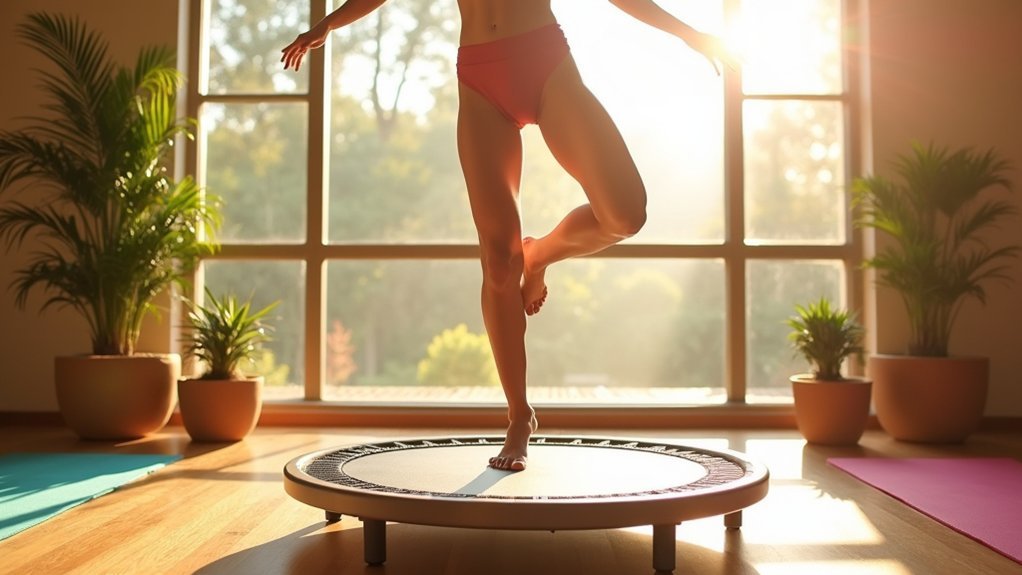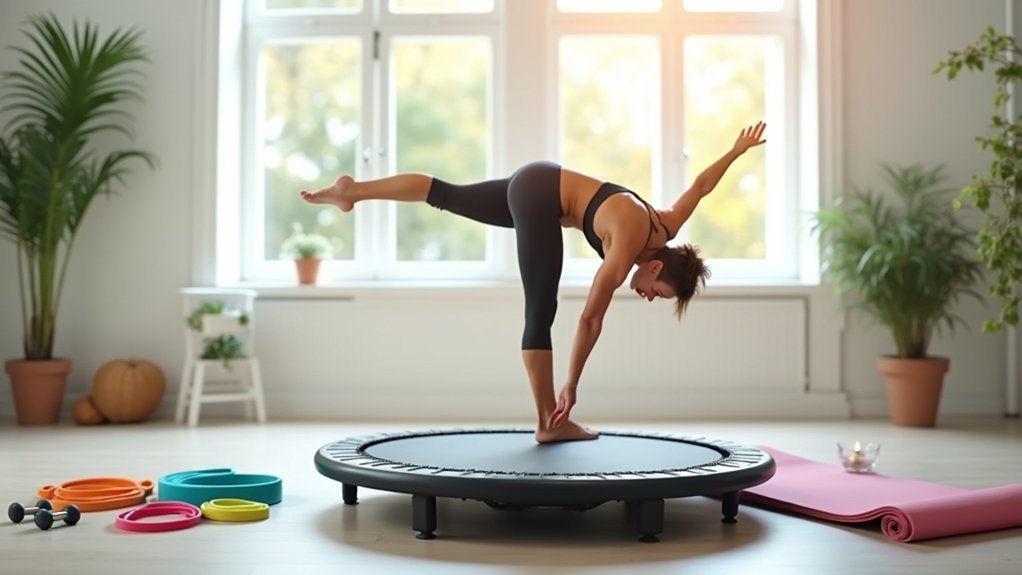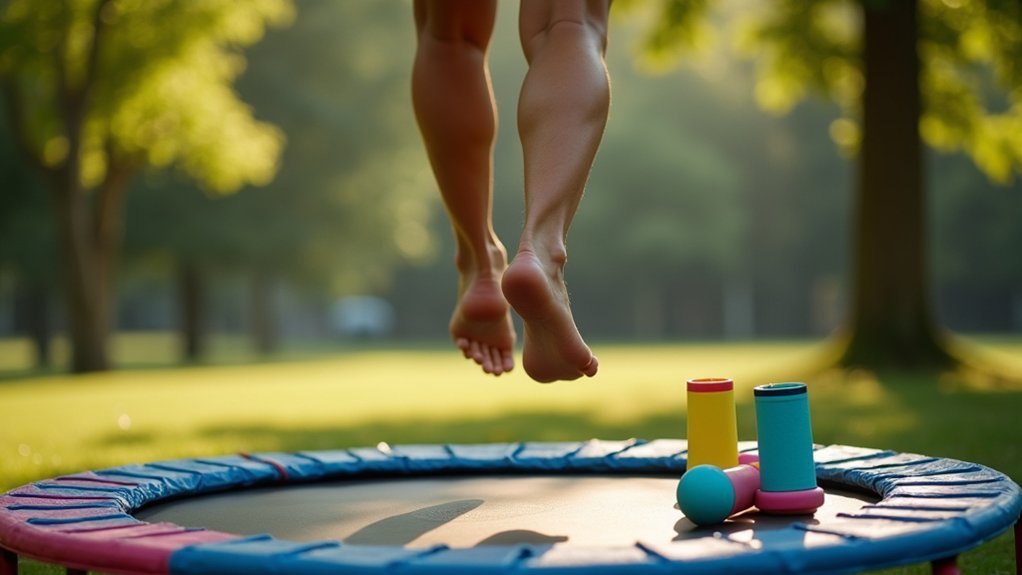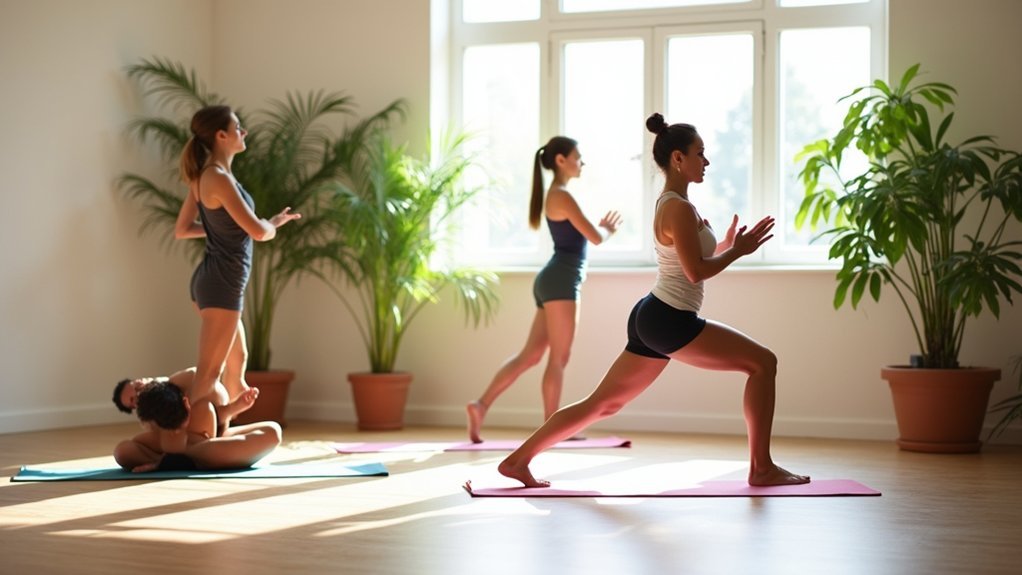Three easy low-impact rebounding moves that tone muscles include Basic Bounce (stand hip-width apart, bounce 1-2 inches), Leg Jacks (alternate between feet wide and narrow while bouncing), and Seated Rebounding Presses for upper body. These moves engage multiple muscle groups simultaneously while protecting your joints. You’ll activate both primary muscles and stabilizers for balanced development. Discover how NASA research shows rebounding delivers stronger biological benefits than running.
Why Low-Impact Rebounding Is Your Secret Muscle-Toning Weapon

Five powerful benefits make rebounding the unsung hero of fitness routines. This bouncing workout engages your entire body while being gentle on your joints—perfect if you’re avoiding high-impact exercises like running.
You’ll strengthen more than just your legs; rebounding activates both primary muscles and stabilizers, creating balanced muscle development throughout your body. Your core constantly works to maintain balance, improving your posture and stability with every bounce.
What’s particularly impressive is how rebounding strengthens your bones while enhancing joint mobility. It’s accessible regardless of your fitness level, making it ideal for beginners and athletes alike. The gentle bouncing motion also helps stimulate your lymphatic system, aiding in the removal of toxins from your body.
The best part? You’re not just toning muscles—you’re simultaneously improving cardiovascular health, boosting metabolism, and enhancing your balance with this single, efficient exercise.
The Science Behind Rebounding for Muscle Definition
While many dismiss rebounding as a simple bouncing activity, research reveals it’s a scientifically-backed method for developing muscle definition through unique physiological mechanisms.
Your body engages in continuous eccentric loading during landing phases, strengthening muscles without stressing joints.
Every bounce creates eccentric muscle contraction, building strength while protecting your joints from damaging impact.
When you bounce, your body activates proprioceptive stimuli that improve neuromuscular coordination across your entire muscular system. The unstable surface forces constant postural adjustments, stimulating core stabilizers and spinal muscles for better definition. NASA’s research indicates that rebounding creates stronger biological responses than traditional running while being gentler on the body.
Studies show rebounding outperforms traditional exercises in building balanced muscle tone, with 70% of participants reporting increased muscle definition.
The alternating compression and decompression create metabolic activation that enhances calorie burn while maintaining lean muscle.
Just 20-45 minute sessions, three times weekly, produce measurable improvements in only 8-12 weeks.
Essential Equipment for Your Rebounding Muscle-Toning Journey

Selecting the right rebounder forms the foundation of your muscle-toning success, with several essential equipment considerations determining your results. Choose a fitness trampoline with a weight capacity that matches your needs (typically 220-300 lbs) and consider models with adjustable tension systems to customize your workout intensity. For additional safety and confidence during workouts, some models offer stability handlebars that are particularly helpful for beginners.
| Equipment Type | Key Features | Best For |
|---|---|---|
| Mini Trampolines | Portable, 30-40″ diameter | Space-saving workouts |
| Foldable Models | Steel frame, collapsible | Storage efficiency |
| Stability-Enhanced | 6-8 leg configuration | High-intensity moves |
| Hybrid Designs | Integrated resistance bands | Full-body toning |
| Smart Rebounders | Workout tracking sensors | Progress monitoring |
Don’t overlook safety features like padded edge covers and non-slip feet. For muscle targeting, look for models with handlebars or incline legs for glute activation.
Master These 3 Beginner-Friendly Rebounding Moves
Now that you’ve equipped yourself with the proper rebounder, it’s time to learn the fundamental movements that will kickstart your muscle-toning journey.
Start with the Basic Bounce Technique: stand with feet hip-width apart, knees slightly bent, and gently bounce 1-2 inches. This low-impact movement engages your core, quads, and glutes while improving circulation at 120-150 bpm.
Master the foundation first: a gentle bounce with bent knees activates your entire lower body while boosting circulation.
Next, try Leg Jacks: jump your feet wide then narrow while maintaining a soft bounce. This variation tones inner and outer thighs while burning 100-150 calories in just 20 minutes.
For upper body focus, perform Seated Rebounding Presses on the rebounder’s edge. This move targets shoulders, triceps, and chest muscles with less joint stress than floor exercises. Incorporating interval training with 40 seconds of work followed by 10 seconds of rest maximizes calorie burn while preventing fatigue.
How to Progress Your Rebounding Routine for Maximum Results

Once you’ve mastered the basic rebounding moves, it’s time to challenge your body further to maximize muscle toning and cardiovascular benefits.
Gradually increase intensity by shifting from simple marching to high knees and single-leg hops that strengthen your glutes, quads, and hamstrings.
Incorporate interval training (20 seconds intense jumping, 10 seconds rest) to boost cardiovascular efficiency.
Add complexity with scissors steps and surf twists to engage your core and improve coordination. These movements activate your obliques and enhance spinal rotation while maintaining balance. The low-impact nature of rebounding makes it easy on joints while still providing an effective workout.
For upper body toning, integrate light dumbbells during your rebounds.
Try synchronized arm movements like punches or overhead presses while jumping.
Always maintain proper joint alignment and core engagement throughout your routine to protect your spine and maximize results.
Frequently Asked Questions
Can Rebounding Help With Specific Problem Areas Like Cellulite?
Yes, rebounding can help reduce cellulite. It stimulates lymphatic flow, enhances circulation, activates muscles beneath problem areas, and accelerates fat metabolism—all directly targeting the physiological factors that cause cellulite’s appearance.
How Does Rebounding Compare to Swimming for Muscle Toning?
You’ll get full-body toning with both activities. Rebounding engages your core, leg, and pelvic muscles repeatedly, while swimming works virtually all major muscle groups through water resistance. Both are gentle on joints.
Is Rebounding Safe for Those With Knee or Back Problems?
Rebounding is generally safe for your knee and back issues. It’s a low-impact exercise with 1/6 the force of pavement activities. Start slowly and consult your healthcare provider for personalized guidance if you have severe conditions.
Can Seniors Effectively Use Rebounding for Muscle Maintenance?
Yes, you can effectively use rebounding for muscle maintenance as a senior. The low-impact nature, balance challenges, and variable resistance help preserve muscle mass while minimizing joint strain during your workout sessions.
How Many Calories Does a Typical Rebounding Session Burn?
You’ll burn about 9.4 calories per minute during rebounding. A 30-minute session typically burns 200-300 calories, depending on your weight, intensity level, and individual factors. More vigorous workouts increase calorie burn considerably.
In Summary
Incorporating rebounding into your fitness routine gives you a fun, effective way to sculpt lean muscle without stressing your joints. You’ll notice improvements in muscle tone and definition within weeks of practicing these three simple moves. Start with the basics, then gradually increase intensity as your confidence grows. Whether you’re a fitness newbie or seasoned athlete, these low-impact exercises will transform your body and boost your energy.





Leave a Reply